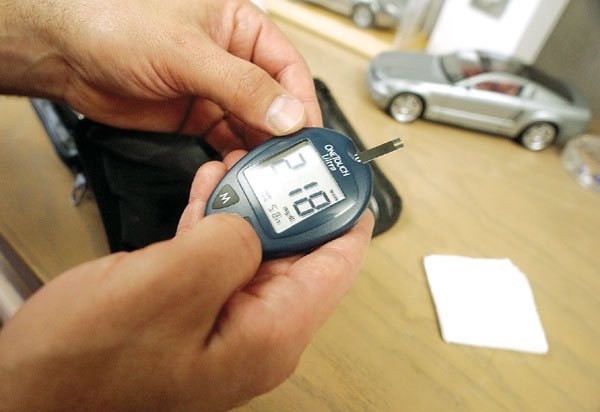When Rafael Arce began training for Mt. Madonna YMCA’s new diabetes prevention program, he related on a personal level to its importance in the South County community.
Five years ago, Arce – Director of the YMCA’s Healthy Living programs – was diagnosed as pre-diabetic.
“I knew my diet was not the best, but my first reaction was denial,” recalled Arce, whose family does not have any history of the chronic condition.
One year and more blood work later, Arce’s situation was the same.
So the 41-year-old told himself: “I need to start making some changes.”
He started eating better and making an effort to be more active. The results paid off. His last doctor’s visit earlier this year showed Arce considerably lowered his risk of developing diabetes.
“It all comes down to the individual. If they want to make changes, they are going to do it,” said Arce, who works out of the First Street office in Gilroy, where a brand new diabetes prevention program is already three weeks in with seven participating members. A second Morgan Hill program is expected to start in January.
Lifestyle changes, like those made by Arce, are at the crux of the YMCA’s brand new, 12-month-long support group program, which has two major goals. This includes reducing each participant’s body weight by 7 percent and increasing their physical activity to 150 minutes per week.
The Mt. Madonna YMCA is one of 11 branches under the YMCA of Silicon Valley network. The Gilroy facility and another in South San Jose, which has six participants, are the first two to offer the diabetes prevention program. The YMCA of Silicon Valley plans on gradually implementing the program at each of its facilities throughout the county as demand grows.
“If we can educate the adults in a family, they will make lifestyle changes that will impact the entire family,” said Executive Director Kelly Ramirez for the Mt. Madonna YMCA.
Two out of every three children in Gilroy, and one out of every three children in Santa Clara County, suffers from obesity, according to Ramirez.
A program aimed specifically at undercutting a condition afflicting 14 percent of Gilroyans, as cited in the Santa Clara Health Department’s 2009 Behavioral Risk Factor Survey, was needed in South County, according to Ramirez.
“This is actually a huge, huge effort in the county’s Public Health Department,” said Cody. “(The YMCA program) really sounds like a model program.”
Overall, Gilroy (with a population of 48,821 in 2012) has the highest diabetes rate out of four cities profiled by the County Health Department. San Jose (12 percent) and Mountain View (8 percent) have the second and third highest diabetes rates of all the cities profiled for diabetes in the report.
Approximately 68 percent of Gilroyans and 55 percent of county residents are overweight or obese – a precursor to developing diabetes, according to the health department, which did not do a report on diabetes or obesity rates for Morgan Hill.
More adults in Gilroy (52 percent) reported not performing any vigorous physical activity than adults in the county (46 percent), according to the 2010 Santa Clara County Health Profile Report.
It’s not just adults who are struggling, either. The Gilroy Unified School District has the highest amount of overweight/obese high school students in the county (more than 24 percent), according to the 2011 Health and Social Inequities report for Santa Clara County. Students in the Morgan Hill Unified School District have a moderate obesity risk of 17 to 24 percent.
The YMCA’s diabetes prevention program, supported by the Diabetes Prevention and Control Alliance, is part of the Center For Disease Control and Prevention-led National Diabetes Prevention Program. The cost is $190 for YMCA members and $325 for non-members. United Health Care Insurance may reimburse the cost, according to the YMCA.
Additionally, Ramirez said the YMCA does not turn anyone away and has financial assistance available for those who can’t afford it.
Interim Health Officer Dr. Sara Cody for the county explained that obesity and physical inactivity are the two leading, “modifiable” risk factors in diabetes, while age, heredity and race/ethnicity are uncontrollable ones.
Hispanic adults are 1.7 times more likely than non-Hispanic white adults to be diagnosed with diabetes, according to the Centers for Disease Control and Prevention. Gilroy is 58 percent Hispanic, while Morgan Hill is 34 percent Hispanic, according to the health department.
Gilroy’s diabetes prevention program meets at 6 p.m. every Monday at 1057 First St. for the first 16 weeks and then monthly for the remainder of the year. Each session offers a new health-conscious challenge. After the fourth week, participants are allowed to sign up free of charge for other YMCA fitness courses in Gilroy.
“It’s going really, really good,” said Jessica Redfield, Mt. Madonna YMCA Health & Wellness coordinator who, along with bilingual colleague Christina Torres, holds the program every Monday in Gilroy with a group of seven Hispanic women.
“They opened up the very first session. They really shared their worries and their family histories,” Redfield continued.
Each week, participants weigh in at the beginning of the meeting, then turn in a personal composition notebook containing a log of everything they ate, along with physical activities performed over the previous seven days.
Every session comes with a different lesson. During week two, for example, the focus is on being a “fat detective” and participants learn how to properly read food labels for fat content. Week three is all about “ways to eat less fat,” where members are asked to each day swap out one food item for another that is more nutritious.
Redfield hopes the program will have a trickle-down effect, starting with the adult women currently participating who will hopefully pass the knowledge down to younger family members.
“They are making lifestyle changes for themselves, but it effects the whole family,” Ramirez explained.















